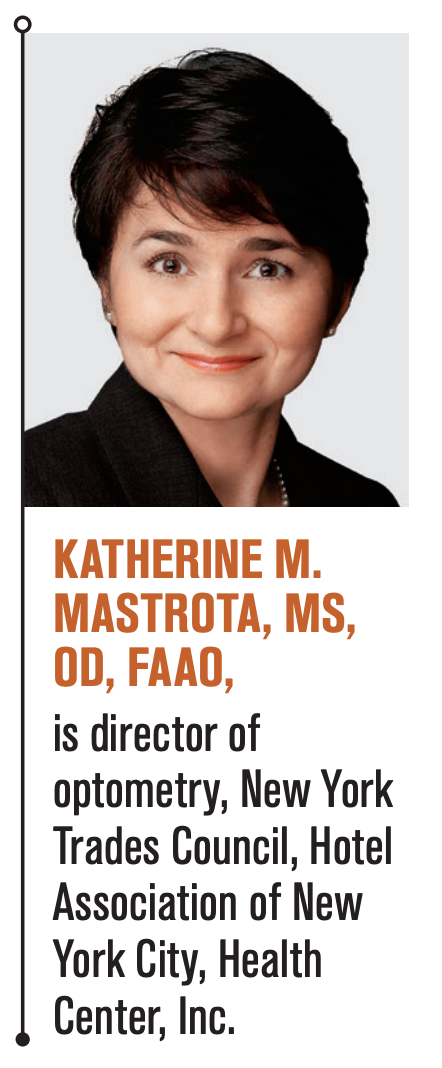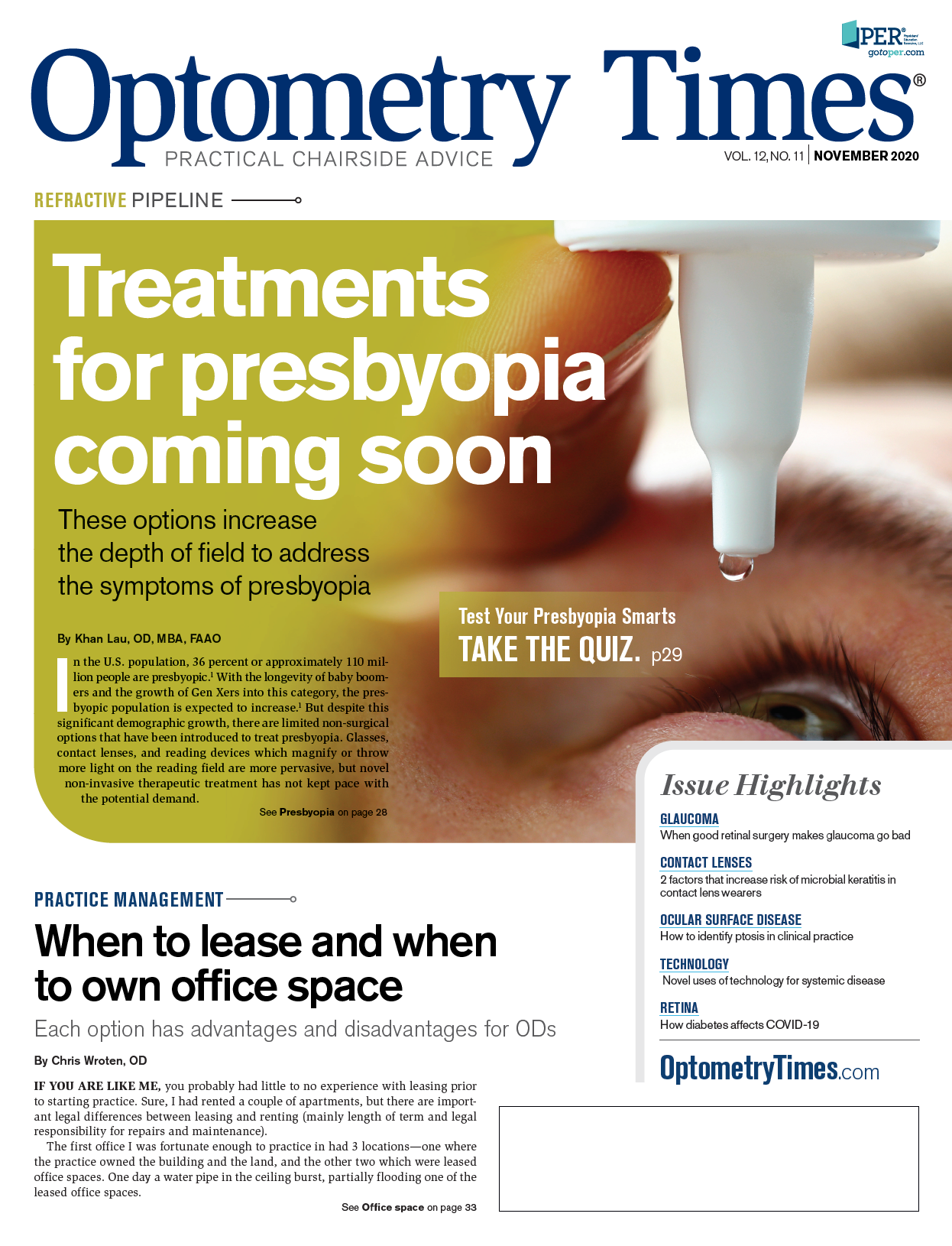5 communication strategies for dry eye patients
Ocular surface disease is chronic, and collaborative care is key to treatment success


For success and efficiency in disease management, OD’s should shift sights from a provider-dependent orientation toward one of patient proactive, preventative, and self-care management in dry eye and other chronic diseases. Active two-way communication is key, along with a shared agenda, openness to ask questions, regular assessments of readiness to change, self-management goals, and corrected misunderstandings of the treatment plan.
The Tear Film and Ocular Surface Society (TFOS) Dry Eye Workshop (DEWS) II report redefines dry eye as a multifactorial disease of the ocular surface.1 For most patients, dry eye is chronic, progressive, and inflammatory in nature.
Chronic disease is defined on the basis of the biomedical disease classification and includes diabetes, asthma, and depression.2 Chronic illness is the personal experience of living with the affliction that often accompanies chronic disease.3
Related: 4 vision-related causes of contact lens discomfort
Importance of communication
As eyecare practitioners, ODs often will cultivate a long-term, personal therapeutic relationship with their dry eye, chronic disease patients. Communication in this relationship is paramount to successful treatment outcomes. Not unlike other disease states, empowering the patient to be engaged in self-care, proactive in medical decision-making, and a contributor to their own healing process potentiates the doctor-patient team effort in disease management.
On the basis of a growing body of evidence of dominant patterns in chronic illness experience from the insider perspective, we now know that communication between chronically ill patients and their healthcare providers has tremendous potential to be instrumental in facilitating coping, self-care management, and an optimal quality of life, or, conversely, in being toxic and damaging to those ideals.4
In more “traditional” doctor-patient interactions, the physician sets the agenda, defines the health objectives, and makes all the medical decisions. The patient is expected to “comply.” This model does not take into account the many reasons why patients might decide not to follow a treatment program.
For example, in a study of patients with diabetes, researchers found that although patients were well informed about their disease and optimal treatment, they perceived that their quality of life might be more adversely impacted by their treatment than by the diabetes itself.5
It is now thought that chronic health conditions require a new paradigm of care because treatment is lifelong and requires the patient to be an active participant in that care.
That new paradigm is “collaborative care,” which emphasizes self-management support, or the need to enhance patients’ skills and self-efficacy in managing their chronic illnesses. Medical decisions are made collaboratively within the partnership of the patient and medical provider team.6
It seems fitting that ODs include ocular surface disease into this management shift.
Related: Topical presbyopia management: Threat or opportunity?
Strategies to promote selfmanagement
These 5 strategies help patients with chronic illness are adapted from Boxer and Snyder in Family Practice Management in 2009.7 The first three strategies “set the stage” for collaboration between the doctor and patient:
1. SET A SHARED AGENDA.
The physician may have a clear idea of what should be discussed but often does not share this information with the patient. Likewise, the patient may be concerned with certain questions but may not feel comfortable asking the physician.
Setting an agenda allows important topics to be laid out at the beginning of the visit.
Agenda setting can start by asking, “Mrs. Jones, what would you like to discuss today?” The patient and the physician then decide together which concerns take priority. This helps to ensure that the topics most important to each are addressed and allows the physician to redirect the discussion back to these topics if necessary.
Setting the agenda together conveys interest in the patient’s priorities and invites the patient to take an active role in the discussion.
2. ASK-TELL-ASK.
This strategy provides a structure for the physician to tailor information to the patient’s needs by:
– Asking the patient what he already knows or wants to know about his illness
– Telling the patient what he needs to know
– Asking or ascertaining whether the patient understands the information or has additional questions
Related: AI and the modern optometric practice restart
3. ASSESS READINESS TO CHANGE.
Patients will differ in their readiness to change their health habits even if they are well informed about the importance of such changes. For behavior change to take place, the individual must feel that the change is important (motivation) and feel capable of making the change (self-efficacy). Two simple questions can assist the physician in addressing these necessary preconditions for change in just a few minutes.
The first question is, “How important is it to you to make this change, on a scale of 0 to 10, with 10 being extremely important?”
Self-efficacy is the second point to be assessed by asking, “How confident are you that you can make this change, on a scale of 0 to 10, with 10 being extremely confident?”
Patients need to feel confident that they can make changes that will positively impact their health/disease state. Many patients have experienced only failure in making health changes and are doubtful of their ability to effectively influence their health. Patients who think they must make immediate, extreme changes to their daily routine may prematurely conclude that they cannot make any changes at all.
Eyecare providers can increase patient confidence by emphasizing how small, incremental steps can improve their symptoms/disease state/ocular health.
The last two strategies invite patients to take action to improve their condition/health.
Related: Lifestyle interventions to prevent dry eye disease
4. SET SELF-MANAGEMENT GOALS.
Doctors and other staff members can help patients identify incremental changes in their health behavior that are realistic for them to achieve. In discussing the self-management goal, it is useful to again assess the patient’s confidence that she will be able to carry it out. Goals should be specific (for example, commit to lid hygiene), limited (for example, specific directions or products for 1 month after which goals can be continued or modified at the next visit), achievable, and measurable.
Keep in mind that it is preferable to develop goals that measure behavior rather than results.
5. CLOSE THE LOOP.
Research has shown that as many as half of patients have misunderstood some portion of what was discussed at their doctor’s visit.8 Having the patient verbalize key instructions allows the physician to correct misunderstandings before they become errors.
Shift in thinking
For success and efficiency in disease management, let’s shift our sights from a provider-dependent orientation toward one of patient proactive, preventative, and selfcare management in dry eye and other chronic diseases. Active 2-way doctor-patient communication is key to achieve this goal.
More by Dr. Mastrota: Why patient occupation matters with dry eye disease
References
1. Craig JP, Nelson JD, Azar DT, Belmonte C, Bron AJ, Chauhan SK, de Paiva CS, Gomes JAP, Hammitt KM, Jones L, Nichols JJ, Nichols KK, Novack GD, Stapleton FJ, Willcox MD, Wolffsohn JS, Sullivan DA. TFOS DEWS II Report Executive Summary. Ocul Surf. 2017 Oct;15(4):802-812.
2. Bentzen N. WONCA dictionary of general/family practice. Copenhagen: World Organization of Family Doctors (WONCA) International Classification Committee; 2003.
3. Walker C. Recognising the changing boundaries of illness in defining terms of chronic illness: a prelude to understanding the changing needs of people with chronic illness. Aust Health Rev. 2001;24(2):207- 14.
4. Thorne SE. Promoting health at the client professional interface. In: Young LE, Hayes VE, eds. Transforming Health Practice: Concepts, Issues, and Applications. Philadelphia: FA Davis Co; 2001:59-70.
5. Huang ES, Brown SES, Ewigman BG, Foley EC, Meltzer DO. Patient perceptions of quality of life with diabetes-related complications and treatments. Diabetes Care. 2007 Oct;30(10):2478-2483.
6. Holman H, Lorig K. Patients as partners in managing chronic disease. BMJ. 2000 Feb 26;320(7234):526-527.
7. Boxer H, Snyder S. Five communication strategies to promote self-management of chronic illness. Fam Pract Manag. 2009 Sep-Oct;16(5):12-6.
8. Man AKY, Chu MC, Chen PP, Ma M, Gin T. Clinical experience with a chronic pain management programme in Hong Kong Chinese patients. Hong Kong Med J. 2007 Oct;13(5):372-8.

Newsletter
Want more insights like this? Subscribe to Optometry Times and get clinical pearls and practice tips delivered straight to your inbox.